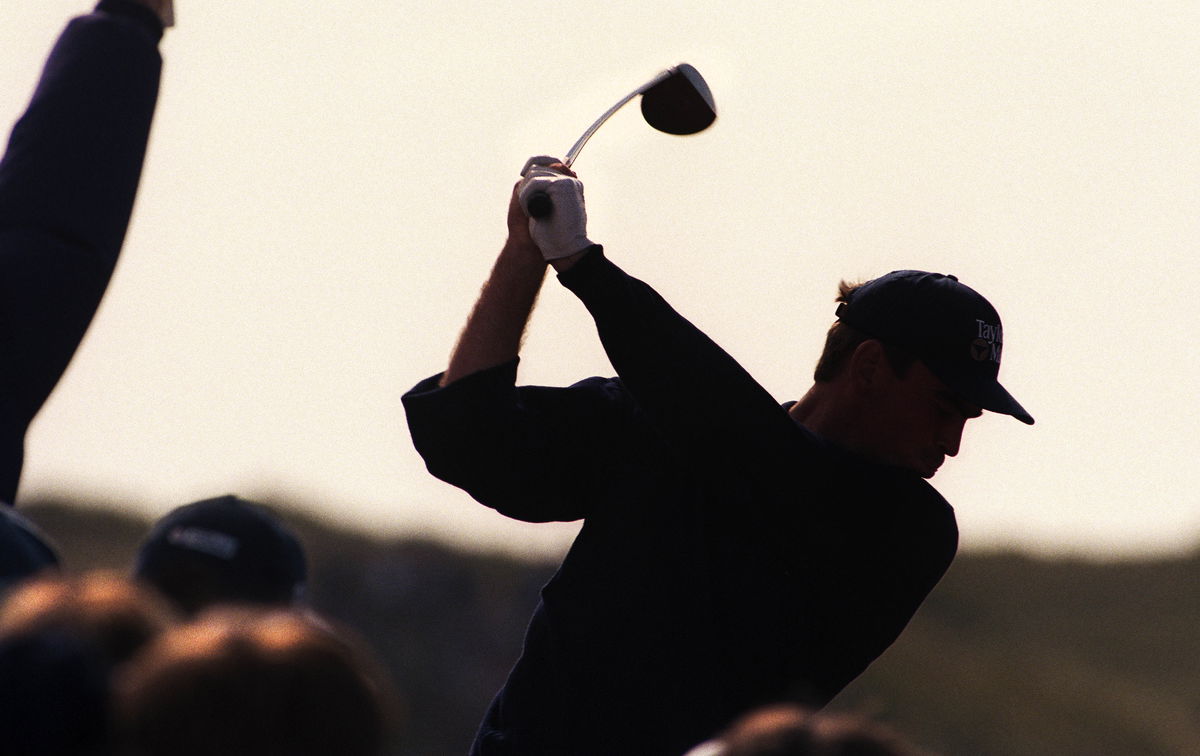
Getty
Silhouetted golfer on the tee during the 127th British Open Golf at Royal Birkdale GC in Southport 16th-19th July 1998. (Photo by David Ashdown/Getty Images)

Getty
Silhouetted golfer on the tee during the 127th British Open Golf at Royal Birkdale GC in Southport 16th-19th July 1998. (Photo by David Ashdown/Getty Images)
Most amateur or club golfers make the same mistake on the course, and we hardly even think about it. We aim down the middle of the fairway, then aim exactly at every pin as if we’re pros, only to self-destruct more than we should. Instead of planning where the shots shouldn’t end up, we mindlessly strategise. Drives end in trouble, approach shots miss the green, and suddenly a routine round feels like a disaster. Instead of finding ways to cut down on scores, most of us end up making silly errors that we do not realise with time.
Watch What’s Trending Now!
Will Zalatoris has seen this pattern countless times in many players, and he knows exactly how to fix it. The PGA Tour pro from Texas, who will return to play in December after nearly a month five hiatus due to a back injury, has built a game rooted in smart choices, and he isn’t hesitant to share the simple, practical tweaks that can shave a couple of strokes off your round. In a 2023 TorchPro podcast, which the PGA Tour shared again today on X, Zalatoris laid out what he calls the “recipe” for turning a 12-handicap round into a scratch golfer.
Let’s dive in.
ADVERTISEMENT
Top Stories
Jordan Spieth Loses Crucial PGA Tour Privilege After Unexplained 3-Month Absence

Tiger Woods Accepts New Job That Could Change PGA Tour Forever

Rory McIlroy Confirms Everyone’s Worst Fears With New LIV Golf-PGA Tour Merger Update

Tiger Woods Quietly Plays Key Role in PGA Tour Shake-Up Talks Amid Injury Struggles

Scottie Scheffler Enters Rare Air With Tiger Woods Through Feat Even Rory McIlroy Never Achieved

1. “Get on the green as fast as you can.”
This is Zalatoris’ first key step to cutting down strokes. And no, by this, he doesn’t mean running to it as fast as possible. He means try to get there in as few shots as possible, and as often as possible. But for this, of course, the crucial step is having ample distance off the tee. According to Zalatoris, every extra 10 yards you gain off the tee “basically correlates to one stroke off your scoring average.” And if you want to push toward a scratch handicap, your drives need to routinely reach close to 280 yards.
Sure, there will be a lot of work on the range to improve your distance. But it is also key to understand how far you actually drive the ball, as it is a common misconception among golfers. According to an AAA study, most 12‑handicap golfers think they hit farther than they really do, sometimes by a lot. And in that study, 10-15 handicappers (male) usually drive an average of only 220.4 yards.
ADVERTISEMENT
That overestimation tricks you into thinking you’re playing well, until you’re left short-sided time and again. So Zalatoris says — “As a 12-handicap, if you hit as many greens as you possibly can, even just taking wedges from 100 yards and aiming 30 feet away from it. You’ll laugh at how few doubles you’ll have.”
By committing to longer drives, you start hitting more fairways, you’re in a better position for your approach shot, and you suddenly find yourself closer to making birdies than doubles.
ADVERTISEMENT
2. “Take more club.”
Another common mistake Will Zalatoris noted was how often good golfers, even mid‑handicappers, come up short because they don’t take enough club. Most times, players want to brag about how less of a club they can use to get on the green. But that costs them. It’s a preventable mistake that ruins your chances of hitting greens.
According to Arccos, a swing-tracking data tool, golfers with 15+ handicaps miss by a wide margin — nearly 30 % of the time from 50–75 yards, and more than half the time from 125–150 yards. And that is the difference between players making a par or a double. This rule also helps players achieve the first rule we talked about, about reaching the greens quickly.
ADVERTISEMENT
So, if you simply know your yardages, take more club and don’t fall short of the green in your approach shots, you’re already halfway there in saving a lot of strokes. Maybe not every time, but often enough to save yourself from needless bogeys.
Wanting to become a scratch golfer? Here’s some Monday motivation from @WillZalatoris to improve your handicap.
“I would say get on the green as fast as possible … As a 12-handicap, if you hit as many greens as you possibly can, even just taking wedges from 100 yards and… pic.twitter.com/7t9Rp7rZl2
— PGA TOUR (@PGATOUR) November 24, 2025
ADVERTISEMENT
3. “Eliminate doubles.”
Another key to improving your handicap is when you learn how to eliminate double bogeys from your scorecard, as Zalatoris points out. You can have the most flawless stretch, stringing together nine pars in a row. But if you end up making a double or worse, all that good work evaporates. “How do you get from a 12 handicap to an 8? Make fewer doubles, that’s it,” Zalatoris says.
4. “Master multiple shots around the green.”
Once you’ve sorted out your driving, club selection, and minimized making doubles, you need to focus on mastering various shots around the green. To go from an 8‑handicap to a 5, or from a 5 to a scratch player, you have to get creative around the greens. That means mastering high flop shots, low spin chips, bump & run chips, etc, whatever it takes to save par from everywhere.
Zalatoris knows this from firsthand experience. He says you should be able to think, “I now have multiple shots with wedges around the green.” It’s not just about hitting good shots; it’s about having options. When you’re able to execute different kinds of shots on demand, you’re not just relying on luck anymore. You’re relying on your skill.
He adds that “Going from a 10 to a five, and going from a five to a zero is light years different.” And he’s right. Because at that level, it’s not about hitting it far or straight. It’s about thinking ahead, how you can get creative even when in trouble and still finish strong.
Will Zalatoris doesn’t just say that if you do these four things, you’ll be great. He frames them as a system, almost like a blueprint. In fact, he even gave a gist of what Tiger Woods‘ blueprint possibly looked like — no three‑putts, no doubles or bogeys on par fives, no missed up‑and‑downs & no penalty shots. While this was his go-to strategy for tournaments, Zalatoris notes that even “if he did do one (of these things) over an entire tournament, he won like 90% of the time.”
But that was his level of it. For players like Zalatoris, who probably had eight of these when he won, it’s different. And so is the case for higher handicappers. “That just gives you the perspective of like, look, good golf is actually not something super sexy. It’s just like, hey, if you want to go shoot 65, go birdie all the par fives, maybe hit one or two wedges close, and you make one 30-footer. That’s seven birdies right there,” he stated.
ADVERTISEMENT
ADVERTISEMENT
ADVERTISEMENT

